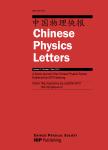Photodoping-Modified Charge Density Wave Phase Transition in WS_(2)/1T-TaS_(2) Heterostructure
作者机构:Beijing Information Technology CollegeBeijing 100015China CAS Key Laboratory of Standardization and Measurement for NanotechnologyCAS Center for Excellence in NanoscienceNational Center for Nanoscience and TechnologyBeijing 100190China Beijing National Laboratory for Condensed Matter PhysicsInstitute of PhysicsChinese Academy of SciencesBeijing 100190China University of Chinese Academy of SciencesBeijing 100049China Max Planck Institute for Chemical Physics of SolidsDresden 01187Germany Songshan Lake Materials LaboratoryDongguan 523808China
出 版 物:《Chinese Physics Letters》 (中国物理快报(英文版))
年 卷 期:2024年第41卷第5期
页 面:144-170页
核心收录:
学科分类:0808[工学-电气工程] 0809[工学-电子科学与技术(可授工学、理学学位)] 07[理学] 0817[工学-化学工程与技术] 070205[理学-凝聚态物理] 0703[理学-化学] 0702[理学-物理学]
基 金:supported by the National Key Research and Development Program of China (Grant No. 2021YFA1400201) the CAS Project for Young Scientists in Basic Research (Grant No. YSBR059) the Beijing Natural Science Foundation (Grant No. 4191003) the National Natural Science Foundation of China (Grant No. 11774408) the Scientific Instrument Developing Project of the Chinese Academy of Sciences (Grant No. GJJSTD20200005) the Strategic Priority Research Program of Chinese Academy of Sciences (Grant Nos. XDB36000000 and XDB30000000) the International Partnership Program of Chinese Academy of Sciences (Grant No. GJHZ1826) CAS Interdisciplinary Innovation Team
主 题:doping transition Transition
摘 要:Controlling collective electronic states hold great promise for development of innovative devices. Here, we experimentally detect the modification of the charge density wave(CDW) phase transition within a 1T-TaS_(2) layer in a WS_(2)/1T-TaS_(2) heterostructure using time-resolved ultrafast spectroscopy. Laser-induced charge transfer doping strongly suppresses the commensurate CDW phase, which results in a significant decrease in both the phase transition temperature(T_(c)) and phase transition stiffness. We interpret the phenomenon that photoinduced hole doping, when surpassing a critical threshold value of ~ 10^(18)cm^(-3), sharply decreases the phase transition energy barrier. Our results provide new insights into controlling the CDW phase transition, paving the way for optical-controlled novel devices based on CDW materials.



